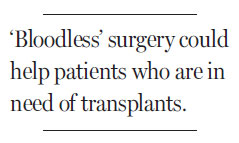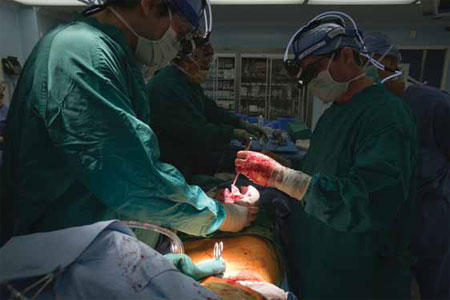Hint at a future without the need for transfusions
Updated: 2013-03-17 08:37
By Kevin Sack(The New York Times)
|
|||||||
|
Rebecca Tomczak, near left, a Jehovah's Witness, had a lung transplant without a transfusion of blood. Photographs by Eric Kayne for The New York Times |


HOUSTON - Last April, after being told that only a transplant could save her from a fatal lung condition, Rebecca S. Tomczak began calling top-ranked hospitals in the United States. She was often told to look elsewhere.
The reason: Ms. Tomczak, then 69, is a Jehovah's Witness who insisted that her transplant be performed without a blood transfusion. The Witnesses believe that Scripture prohibits the transfusion of blood, even one's own, at the risk of forfeiting eternal life.
Given the complexities of lung transplantation, in which transfusions are routine, some doctors felt the procedure posed unacceptable dangers. Besides, with more than 1,600 desperately ill people waiting for a donated lung, was it appropriate to give one to a woman who might needlessly sacrifice her life and the organ along with it?
Then Ms. Tomczak - who had sarcoidosis, a progressive condition of unknown cause that leads to scarring in the lungs - found Dr. Scott A. Scheinin at The Methodist Hospital in Houston.
He had become persuaded by a growing body of research that transfusions often pose unnecessary risks. By picking patients with low odds of complications, Dr. Scheinin felt he could operate almost as safely without blood as with it. The way he saw it, patients declined lifesaving therapies all the time, for all manner of reasons, and it was not his place to deny care just because those reasons were sometimes religious or unconventional.
"At the end of the day," he had resolved, "if you agree to take care of these patients, you agree to do it on their terms."
Ms. Tomczak's case - the 11th so-called bloodless lung transplant attempted at Methodist over three years - would become the latest test of an innovative approach that was developed to accommodate the unique beliefs of the world's eight million Jehovah's Witnesses but may soon become standard practice for all surgical patients.
Unlike other patients, Ms. Tomczak would have no backstop. Explicit in Ms. Tomczak's understanding with Dr. Scheinin was that if something went terribly wrong, he would allow her to bleed to death.
The approach Dr. Scheinin uses - originally called "bloodless medicine" but later re-branded as "patient blood management" - has been around for decades. The first bloodless lung transplant, at Johns Hopkins in Baltimore, Maryland, was in 1996. But nearly 17 years later, the degree of difficulty for such procedures remains high.
None of the 10 patients who preceded Ms. Tomczak, including two who had double-lung transplants, had problems related to surgical blood loss or postoperative anemia, Dr. Scheinin said.
Dr. Scheinin, 52, said his focus during such operations was intensified by the knowledge that if a patient died, a second life might hang in the balance - the wait-listed patient who would otherwise have received the organ.
"If I agree to do an aortic bypass on a patient who refuses blood, and it's a risk we're both willing to take, that's between me and him," Dr. Scheinin said. "With a transplant, if the patient dies, you risk having people say you wasted a precious organ."
But Dr. Scheinin and his team are also motivated by the broader agenda - of limiting transfusions for all surgical patients, not just those with religious objections. Recent data show that one of every 400 units transfused is associated with an adverse event like circulatory overload or sepsis.
Yet at dozens of hospitals with programs that cater to Jehovah's Witnesses, a million-patient market in the United States, researchers have found that surgical patients typically do just fine without transfusions.
The economy is also helping the blood management movement. Processing and transfusing a single unit of blood can cost as much as $1,200 , and many hospitals are trying to cut back. Administrators at Methodist said their bloodless lung transplants typically cost 30 percent less than other lung transplants, partly because management of hemoglobin levels before surgery has resulted in fewer complications and shorter stays.
Before Ms. Tomczak's surgery, doctors ordered doses of intravenous iron and Aranesp, a drug that stimulates red cell production. They also limited the number of blood draws for lab testing. Every milliliter might count.
As Dr. Scheinin opened the thoracic cavity and began cauterizing his way through tissue, another surgeon suctioned blood. Rather than disposing of it, he routed it through a hose into the cylinder of a cell salvage machine.
A centrifuge spun out the heavy red cells, which were washed with saline and later returned through a port in Ms. Tomczak's jugular vein. The church does not view this as a transfusion because the blood ostensibly remains in a continuous circuit with the body.
The same was true of a process called hemodilution. Doctors removed a unit of blood from Ms. Tomczak and replaced it with saline. This diluted the hemoglobin concentration of her remaining blood, cushioning the impact of any blood loss. The blood was later returned to the body.
Ms. Tomczak's recovery has not been without setbacks, albeit unrelated to her hemoglobin levels. The doctors said scans and a biopsy otherwise showed that the lung was working properly.
Ms. Tomczak has said Jehovah must have been guiding Dr. Scheinin's hand. That is fine with Dr. Scheinin, who is Jewish.
"I wouldn't trade in my surgical skills for a life of piety," he said. "But can anyone deny that a higher power doesn't have some bearing on how this all plays out?"
The New York Times
(China Daily 03/17/2013 page11)
